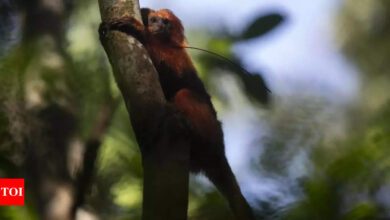World
‘Lord of the Flutes’: Archaeologists in Panama find ancient tomb filled with gold treasure

[ad_1]
NEW DELHI: Panamanian archaeological efforts have led to the significant find of a religious leader‘s grave, dated to over a millennium ago, within the El Caño Archaeological Park. This site, situated in the Coclé province, has been recognized for its rich pre-Columbian history, particularly its grand burial sites. The recent discovery, constituting the ninth tomb unveiled since 2008, harbors not only a cache of golden artifacts but also numerous other remains believed to be sacrificial victims, a CNN report said.
The individuals interred in these tombs, as explained by Dr Julia Mayo of the El Caño Foundation, held esteemed positions within their communities, evident from the gold and ceramic objects accompanying them. The central figure in this latest tomb, presumed to have held a significant religious role, has been nicknamed “Lord of the Flutes” due to the animal bone flutes found alongside him, likely used in sacred rituals.
Investigations into the grave have unveiled the likelihood of the “Lord of the Flutes” having numerous companions in death, suggested by the bodies and offerings surrounding him. This pattern, mirroring the eight previously examined tombs, reinforces the practice of ritual sacrifices accompanying the deceased into the afterlife, the CNN report said.
Distinctively, the “Lord of the Flutes” is thought to have been more a spiritual than a martial leader, differing from other tombs that seemed to contain military figures. This assumption is based on the absence of martial artifacts, such as axes or spears, and the presence of religious items like flutes and bells.
The ongoing excavation aims to unveil the full scope of the burial site by next year. A notable aspect of the burial is the positioning of the leader’s body over that of a woman, a practice uncommon for the period and region, according to Nicole Smith-Guzmán of the Smithsonian Tropical Research Institute.
Artifacts uncovered include gold pectorals, belts, bracelets, and human-figure earrings, alongside items crafted from rare animal teeth. These findings suggest a complex web of social, political, and economic interactions among the ancient Latin American chiefs, facilitating the exchange of precious goods and influencing regional prestige.
The discovery at El Caño continues to shed light on the ceremonial and societal practices of ancient civilizations in Panama, offering new perspectives on their chiefdoms, political economies, and cultural dynamics.
El Caño Archaeological Park in Panama: All you need to know
The El Caño Archaeological Park in Panama is of significant historical and cultural importance for several reasons:
Window into Pre-Columbian Societies: El Caño provides invaluable insights into the social, political, and religious practices of pre-Columbian societies in Central America, particularly those of the ancient Coclé culture. The artifacts and burial practices observed at this site offer clues about the societal hierarchies, trade networks, and cultural beliefs of the time.
Rich Burial Sites: The park is known for its lavish burial chambers, which are believed to belong to high-status individuals. These tombs are filled with a wealth of artifacts, including gold jewelry, ceramics, and items signifying status and power, providing evidence of the craftsmanship, trade, and wealth distribution of the region’s ancient inhabitants.
Archaeological Significance: Continuous excavations at El Caño have led to the discovery of multiple significant archaeological finds. Each new discovery, such as the tombs of elite figures accompanied by sacrificial victims, adds layers of understanding to our knowledge of the Coclé culture and its customs, including funerary rites and social organization.
Cultural Heritage: The park helps preserve Panama’s cultural heritage, serving as a site for education and research. It attracts scholars, students, and tourists, contributing to the broader understanding and appreciation of Panama’s history and pre-Columbian heritage.
Research and Education: El Caño serves as an ongoing research site for archaeologists and historians worldwide. It provides educational opportunities for both the scientific community and the general public, helping to foster a deeper understanding of human history in the Americas.
The individuals interred in these tombs, as explained by Dr Julia Mayo of the El Caño Foundation, held esteemed positions within their communities, evident from the gold and ceramic objects accompanying them. The central figure in this latest tomb, presumed to have held a significant religious role, has been nicknamed “Lord of the Flutes” due to the animal bone flutes found alongside him, likely used in sacred rituals.
Investigations into the grave have unveiled the likelihood of the “Lord of the Flutes” having numerous companions in death, suggested by the bodies and offerings surrounding him. This pattern, mirroring the eight previously examined tombs, reinforces the practice of ritual sacrifices accompanying the deceased into the afterlife, the CNN report said.
Distinctively, the “Lord of the Flutes” is thought to have been more a spiritual than a martial leader, differing from other tombs that seemed to contain military figures. This assumption is based on the absence of martial artifacts, such as axes or spears, and the presence of religious items like flutes and bells.
The ongoing excavation aims to unveil the full scope of the burial site by next year. A notable aspect of the burial is the positioning of the leader’s body over that of a woman, a practice uncommon for the period and region, according to Nicole Smith-Guzmán of the Smithsonian Tropical Research Institute.
Artifacts uncovered include gold pectorals, belts, bracelets, and human-figure earrings, alongside items crafted from rare animal teeth. These findings suggest a complex web of social, political, and economic interactions among the ancient Latin American chiefs, facilitating the exchange of precious goods and influencing regional prestige.
The discovery at El Caño continues to shed light on the ceremonial and societal practices of ancient civilizations in Panama, offering new perspectives on their chiefdoms, political economies, and cultural dynamics.
El Caño Archaeological Park in Panama: All you need to know
The El Caño Archaeological Park in Panama is of significant historical and cultural importance for several reasons:
Window into Pre-Columbian Societies: El Caño provides invaluable insights into the social, political, and religious practices of pre-Columbian societies in Central America, particularly those of the ancient Coclé culture. The artifacts and burial practices observed at this site offer clues about the societal hierarchies, trade networks, and cultural beliefs of the time.
Rich Burial Sites: The park is known for its lavish burial chambers, which are believed to belong to high-status individuals. These tombs are filled with a wealth of artifacts, including gold jewelry, ceramics, and items signifying status and power, providing evidence of the craftsmanship, trade, and wealth distribution of the region’s ancient inhabitants.
Archaeological Significance: Continuous excavations at El Caño have led to the discovery of multiple significant archaeological finds. Each new discovery, such as the tombs of elite figures accompanied by sacrificial victims, adds layers of understanding to our knowledge of the Coclé culture and its customs, including funerary rites and social organization.
Cultural Heritage: The park helps preserve Panama’s cultural heritage, serving as a site for education and research. It attracts scholars, students, and tourists, contributing to the broader understanding and appreciation of Panama’s history and pre-Columbian heritage.
Research and Education: El Caño serves as an ongoing research site for archaeologists and historians worldwide. It provides educational opportunities for both the scientific community and the general public, helping to foster a deeper understanding of human history in the Americas.
#Lord #Flutes #Archaeologists #Panama #find #ancient #tomb #filled #gold #treasure






